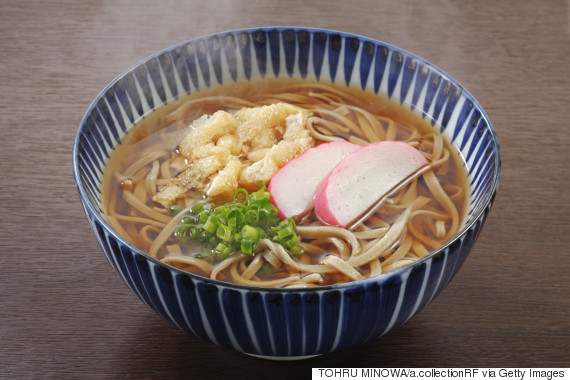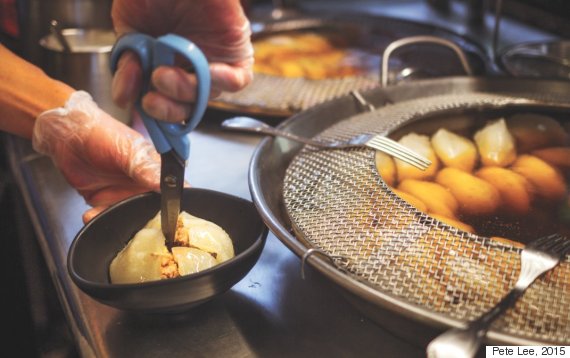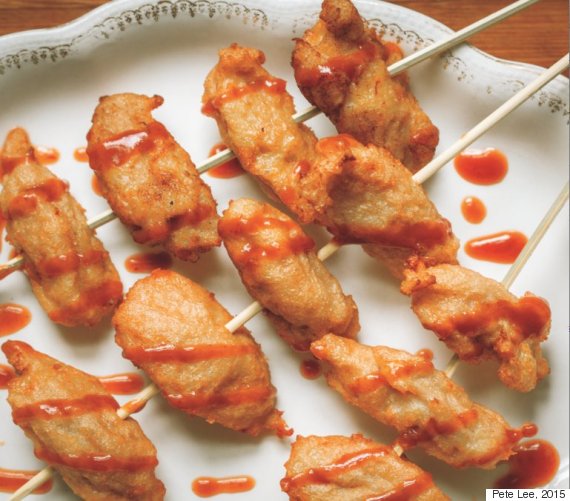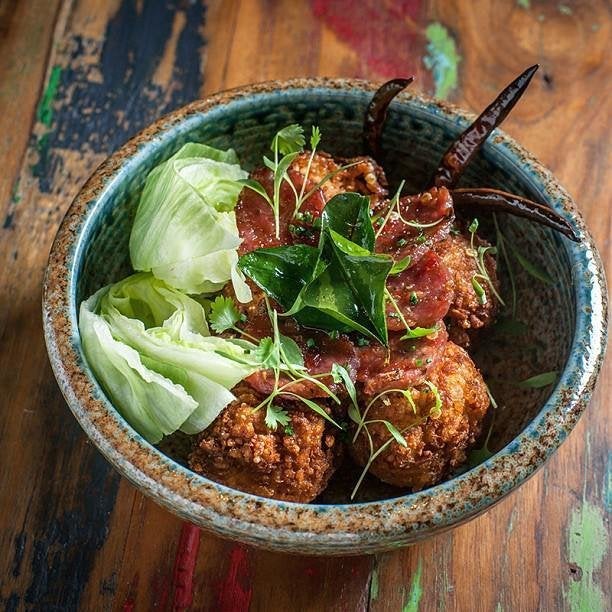
Chewy. Gummy. Bouncy. Rubbery. These aren't typically flattering words when it comes to food.
That is, they're not traditionally complimentary in the United States. In Taiwan and often in other parts of East Asia, it's a different story. These adjectives describe a beloved texture -- a food quality sought after, not shunned. It's called the "Q" texture, or the mystery food characteristic you didn't even know you were missing.
In her new book, The Food Of Taiwan, food writer Cathy Erway describes the "Q" texture amidst recipes for fish cakes and meatball mochi. "Taiwanese eaters are almost as concerned with texture as they are with taste," Erway writes. Think of the tapioca balls in bubble tea, for example. While there is a huge range of textures that are celebrated in Taiwan, Erway says springy is ideal in foods like fish cakes and mochi. A food with the right "Q" factor isn't too soft or bouncy, but rather slightly firm and a little springy. Chef Aida Mollenkamp likens the "Q" texture to "a marshmallow or a good-quality gummy worm."
If you're scratching your head over the letter "Q" and its place among the Chinese characters, you're not alone. "Q" is something of a recent slang term, Erway told The Huffington Post. When and how the letter was adopted isn't entirely clear, but you'll see it today on packaged food, like noodles and mochi, on menus and even in shop names.
One popular food that embodies the texture is the fish cake. In Taiwan and other parts of East Asia, fish cakes are not the flaky or chunky ones Americans picture when they think of crab cakes or salmon patties. They're smooth and chewy. If they're done well, they're "Q!" Getting the hang of it yet?
There are also fish balls, which can be similarly smooth and chewy. Both are made of fish-based pastes and sometimes a combination of meat- and fish-based pastes. The pastes consist of ground-up fresh, boneless fish fillets and scraps of meat and fish that would otherwise not be eaten. The paste is then structured into various shapes and sizes.

In Taiwanese cuisine you will find fish cakes and fish balls dropped into broth or a noodle soup, or fried and eaten with a sweet-and-sour sauce. Erway explains that the gummy textures are so popular among children that fish cakes are now sold in a variety of bright colors and shapes -- a Hello Kitty fish cake, for instance. While you can purchase fish paste and mold your own fish balls, buying ready-made ones is common. "Much like hot dogs and sausages," Erway writes in her book, "these processed meats are complicated to produce in a home kitchen, but widely available in grocery stores."
If you want to try your hand at your own fish cakes, find Erway's recipe for Fried Fish Cakes (Tian Bu La) below. You'll also find a recipe for Meatball Mochi (Ba-Wan or Rou Yuan), which are a traditional southern Taiwanese snack that consist of meat stuffed into clear, stretchy wrappers made from potato and corn starch. Both these recipes and a slew of others are in Erway's book, which goes on sale March 24.
If you're not up for trying your hand in the kitchen, check out your local Asian grocery store to explore the vast variety of these gummy treats, from mochi to packaged fish balls. And next time you're sipping bubble tea, call it "Q," like a boss.
Recipes and photography from THE FOOD OF TAIWAN by Cathy Erway. Copyright © 2015 by Cathy Erway. Used by permission of Houghton Mifflin Harcourt Publishing Company. All rights reserved.
Meatball Mochi (Ba-Wan)
Makes 4 to 6
This traditional southern Taiwanese snack incorporates many Taiwanese penchants: a chewy, jellylike starch; a thick, sweetened sauce; and a savory, pork-studded filling. This dish is translated as “meatball” in Taiwan, but it’s actually a ball of clear, stretchy starch stuffed with meat. So I took the liberty of naming it “meatball mochi” -- due to its similarities with the soft, chewy stuffed dessert.
For the filling
1/2 pound pork shoulder, finely chopped
1/2 cup finely chopped fresh bamboo shoots, or canned, rinsed well
1 teaspoon light soy sauce
1/2 teaspoon cornstarch
1/4 teaspoon salt
1/4 teaspoon ground white pepper
For the wrapper
1/2 cup rice flour
1 cup cold water
2 cups boiling water
1/2 cup sweet potato starch
1 cup corn starch
To continue
Vegetable or peanut oil, for greasing bowls
Sweet-and-Sour Tomato–Based Sauce (see below) or Sweet-and-Sour Citrus and Soy–Based Sauce (see below)
1/2 bunch coarsely chopped fresh cilantro (stems included)
For the filling
In a large bowl, combine the pork, bamboo shoots, soy sauce, cornstarch, salt, and white pepper. You can do this up to a day ahead and store, covered, in the refrigerator.
For the wrapper
In a large bowl, combine the rice flour and 1/4 cup of the cold water and mix until smooth. Whisk in the boiling water and stir well to eliminate any lumps and create a milky, translucent, thick liquid. Combine the sweet potato starch, cornstarch, and the remaining 3/4 cup cold water in a separate bowl. Pour this mixture into the warm rice flour mixture and stir thoroughly until the mixture is thick and there are no lumps (if there are many visible lumps, strain the mixture through a colander).
To continue
Prepare a large steamer with boiling water underneath. Grease the insides of four small, round ramekins (or rice bowls or round sauce dishes) with oil. Scoop about 1 tablespoon of the mochi mixture and spread it on the bottom of the bowl. Place a small scoop of the filling on top of the mixture, followed by another scoop of the mochi mixture. Spread it over to cover the meat mixture completely. Place the bowls in the steamer and steam until the starch is clear and set, about 15 minutes. Remove the bowls carefully. Ladle a scoop of your preferred sauce over each ball and top with the cilantro to serve.
Fried Fish Cakes (Tien Bu La)
Makes about 4 servings
This dish’s name is a phonetic translation of “tempura,” and originated with the Japanese penchant for frying small, snacklike morsels until crisp and bubbly. Once fried, these morsels are sometimes then soaked in a soup, so that their light, spongy texture absorbs a lot of broth. However, they can also be served crispy and topped with a sweet-and-sour sauce like Sweet-and-Sour Tomato-Based Sauce or Sweet-and-Sour Citrus and Soy-Based Sauce.
3/4 pound skinless white-fleshed fish fillets (such as cod), cut into 1-inch chunks
1/4 cup cornstarch
1 teaspoon sugar
1 teaspoon salt
1 teaspoon rice wine
1/4 teaspoon ground white pepper
1/2 cup ice-cold water
3 to 4 cups vegetable or peanut oil, or more as needed, for frying
Sweet-and-Sour Tomato-Based Sauce or Sweet-and-Sour Citrus and Soy-Based Sauce (see below)
In a large bowl, combine the fish with the cornstarch, sugar, rice wine, salt, and white pepper and mix to coat the fish thoroughly. Transfer to a food processor or blender and pulse several times, stopping to scrape down the sides, until the mixture becomes a smooth paste, about 2 minutes. While pulsing, slowly pour in the water. Continue to process until the mixture is a very smooth puree with no visible chunks. Transfer to a bowl, cover and refrigerate at least 2 hours or up to overnight.
Add the oil to a saucepan or wok so that the oil is deep enough to completely submerge a tablespoon-sized drop of fish cake batter (add more oil if necessary). Heat over medium-high heat until a candy thermometer inserted into the oil (but not touching the pan) reads between 350 to 375 degrees F. When cooking, adjust the heat if necessary to retain this temperature.
The cakes can be made in any shape, but long, squiggly or flattened oval-like pieces are common. Just be sure the cakes are roughly the same size, so that they will cook in the same amount of time. Scoop the fish cake batter with a spoon, then push the batter to the edge of the spoon to drop it into the oil in irregular-shaped tubes. Repeat with more batter, working in batches of 4 to 6 cakes at a time so that they fry without touching one another. Fry, turning occasionally, until just lightly golden-brown all around, 3 to 4 minutes. Transfer immediately to paper towels. Repeat with the rest of the batter. Serve immediately with your preferred sauce.
Sweet-And-Sour Tomato-Based Sauce
Makes about 1 cup
You won’t go a few days in Taiwan without encountering this thick, red-tinged sauce. It’s mild-tasting enough to liberally drench foods -- like fried snacks -- in a way that you couldn’t with more potently flavored sauces like soy sauce or ketchup. This sauce relies heavily on ketchup, a condiment associated with Western food trends.
1/4 cup ketchup
1/4 cup rice vinegar
1 tablespoon sugar
1 teaspoon soy sauce
1 teaspoon cornstarch
1/2 cup cold water
Salt to taste
Add the ketchup, vinegar, sugar, and soy sauce to a small saucepan over medium-high heat and stir to combine thoroughly. Cook for a few seconds, stirring, until the sugar dissolves and the mixture is beginning to bubble. In a separate bowl, whisk together the cornstarch and water. Stir into the ketchup mixture and continue to cook, stirring, until thickened, about 1 minute. Add the salt to taste. Remove from the heat and let cool completely before serving.
Sweet-And-Sour Citrus And Soy-Based Sauce
Makes about 1 cup
This sauce can be used interchangeably with Sweet-and-Sour Tomato-Based Sauce, such as for drizzling on tempura fishcakes. The use of fresh, tropical citrus juice is a given due to these fruits’ availability on the island. The bright acidity of the resulting sauce makes it an excellent complement for savory, porky snacks like Meatball Mochi.
1/4 cup fresh orange juice
1 tablespoon fresh lime juice
1 tablespoon rice vinegar
1 tablespoon sugar, plus more to taste
2 teaspoons soy sauce
1 teaspoon cornstarch
1/2 cup cold water
Salt to taste
Add the orange juice, lime juice, vinegar, sugar, and soy sauce to a small saucepan over medium-high heat and stir to combine thoroughly. Cook, stirring, until the sugar dissolves and the mixture begins to boil. In a separate bowl, whisk together the cornstarch and water. Stir into the orange juice mixture and continue to cook, stirring, until thickened, about 1 minute. Add salt to taste. Taste for seasoning and add extra sugar or a pinch of salt as desired. Remove from the heat and let cool completely before serving.
